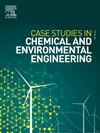g-C3N4纳米颗粒作为有机污染物在甘油中的吸附剂的结构、形态和光学性能优化
Q1 Environmental Science
Case Studies in Chemical and Environmental Engineering
Pub Date : 2024-12-12
DOI:10.1016/j.cscee.2024.101057
引用次数: 0
摘要
解决环境中有机污染物的问题已成为研究人员关注的热点。因此,本研究旨在利用氮化石墨碳纳米颗粒(g-C3N4)吸附降解有机污染物——甘油溶液。随后,进行了基于形态、结构和光学性质的测试。研究结果如下:XRD分析在27.74°处有一个显著峰,证实了材料的层状结构和良好的结晶度。hrtem分析显示最佳平均粒径为8.87 nm。FTIR分析确定了促进降解活性的关键官能团。紫外-可见分析表明,带隙为2.31 eV,能够有效吸收可见光。此外,PL光谱在464 nm和495 nm处显示出发光特性,表明在光子学和传感器方面的潜在应用。甘油降解得到的吸附量为6.5 mg/g,效果较好。这些发现强调了g-C3N4的结构完整性、最佳粒径和良好的光学性能是使g-C3N4成为极具吸引力的降解材料的重要因素。本文章由计算机程序翻译,如有差异,请以英文原文为准。
Optimization of g-C3N4 nanoparticles on structural, morphological, and optical properties as organic pollutants adsorbent in glycerin
Addressing the issue of organic pollutants in the environment has become a hot topic among researchers. Therefore, this study aims to degrade an organic pollutant, precisely glycerin solution, using graphite carbon nitride (g-C3N4) nanoparticles through adsorption. Subsequently, tests were conducted based on morphological, structural, and optical properties. The results obtained in this study are as follows: XRD analysis showed a significant peak at 27.74°, confirming the material's layered structure and good crystallinity. HR-TEM analysis revealed an optimal average particle size of 8.87 nm. FTIR analysis identified key functional groups contributing to degradation activity. UV–Vis analysis indicated a band gap of 2.31 eV, enabling effective visible light absorption.
Additionally, PL spectra demonstrated luminescence properties with peaks at 464 nm and 495 nm, indicating potential applications in photonics and sensors. The adsorption capacity obtained from glycerin degradation was 6.5 mg/g, which is a good result. These findings highlight the structural integrity of g-C3N4, optimal particle size, and favorable optical properties as significant factors that make g-C3N4 highly appealing for degradation materials.
求助全文
通过发布文献求助,成功后即可免费获取论文全文。
去求助
来源期刊

Case Studies in Chemical and Environmental Engineering
Engineering-Engineering (miscellaneous)
CiteScore
9.20
自引率
0.00%
发文量
103
审稿时长
40 days
 求助内容:
求助内容: 应助结果提醒方式:
应助结果提醒方式:


